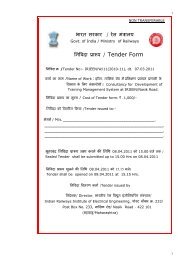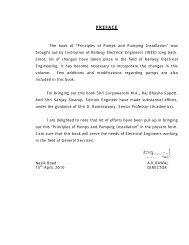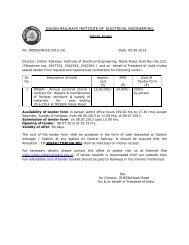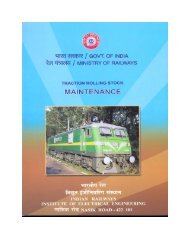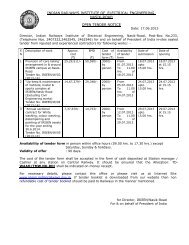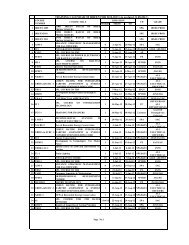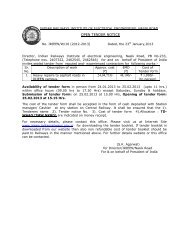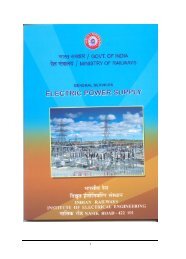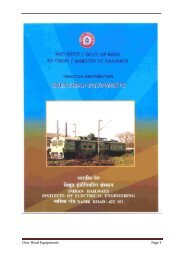remote control equipment - Indian Railways Institute of Electrical ...
remote control equipment - Indian Railways Institute of Electrical ...
remote control equipment - Indian Railways Institute of Electrical ...
Create successful ePaper yourself
Turn your PDF publications into a flip-book with our unique Google optimized e-Paper software.
3.4 Pattern <strong>of</strong> generation <strong>of</strong> gases in transformer is summarized below.<br />
FAULT/PATTERN KEY GAS<br />
Conductor Overheating C0/C02 (Carbon Oxides)<br />
Oil Overheating C2H4 (EthyIene)<br />
Partial Discharge Hz (Hydrogen)<br />
Arcing . C2H2 (Acetylene)<br />
4.0 Solubility <strong>of</strong> Gases<br />
4.1 The solubility <strong>of</strong> gases in oil varies with temperature and pressure.<br />
While solubility <strong>of</strong> H2. N2, CO. O in oil increases with temperature and<br />
that <strong>of</strong> CO2. C2 H2. C2 H4 and C2 H6, decreases with temperature,<br />
solubility <strong>of</strong> CH,. remains essentially constant.<br />
All the gases become more soluble in oil with increase in pressure<br />
Solubility <strong>of</strong> gas is one <strong>of</strong> the factors contributing to the complexities in<br />
formulating permissible levels <strong>of</strong> gases on the basis <strong>of</strong> service life <strong>of</strong> a<br />
transformer. Table I show solubility <strong>of</strong> different gases 25° C and at<br />
1 atm. The homogeneity <strong>of</strong> the gases in the oil is dependent" on the<br />
rate <strong>of</strong> gas generation, access <strong>of</strong> the fault area to flowing oil, rate <strong>of</strong> oil<br />
mixing and presence <strong>of</strong> gas blanket.<br />
5. Dissolved Gas Analysis (DGA)<br />
5.1 Dissolved gas analysis (DGA) <strong>of</strong> the oil <strong>of</strong> a transformer in operation is<br />
a specialized technique to assess the internal condition <strong>of</strong> the<br />
transformer. DGA is performed by Gas Chromatography. The gases<br />
extracted from the oil by a suitable apparatus are transferred to the<br />
Gas Chromatograph system for analysis.<br />
5.2 The knowledge <strong>of</strong> solubility <strong>of</strong> Hydro-carbon and fixed gases at<br />
different temperatures, in insulating oils helps in interpretation <strong>of</strong> gas<br />
analysis. The permissible concentration <strong>of</strong> dissolved gases in the oil <strong>of</strong><br />
healthy transformer is shown in Table II. The combinations <strong>of</strong> Gas<br />
levels for different types <strong>of</strong> faults are shown in Table III while Table IV<br />
shows the gas composition by volume under arcing fault with<br />
participation <strong>of</strong> various components <strong>of</strong> solid dielectrics in a transformer.<br />
5.3 While the absolute concentration <strong>of</strong> fault gases gives an indication <strong>of</strong><br />
status <strong>of</strong> insulation <strong>of</strong> transformer, whereas the relative concentration<br />
<strong>of</strong> these gases provides a clue to the type <strong>of</strong> fault. For fault diagnosis<br />
the method based on Rogers' Analysis is adopted.<br />
5.4 Roger's method:<br />
This method holds good for hydro-carbon gases. By evaluating the gas<br />
ratios, the type <strong>of</strong> fault is detected. Four ratios are used viz.,<br />
Methane/Hydrogen, Ethane/Methane, Ethylene/Ethane and Acetylene/<br />
58




